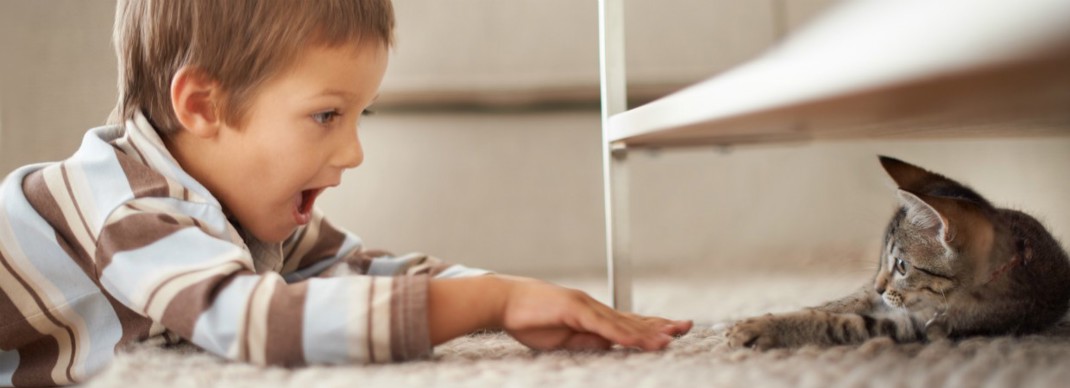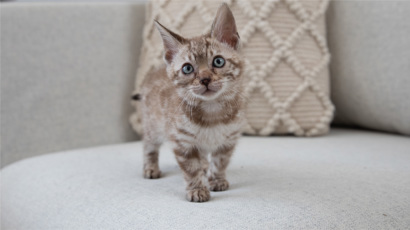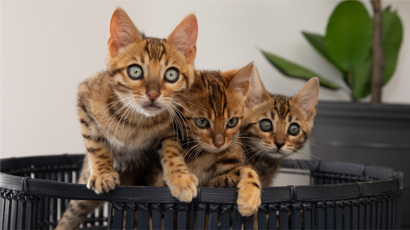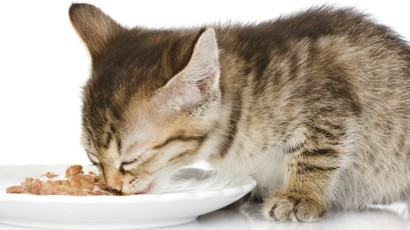Kitten Hygiene and Safety Around The Home

Introducing your new kitten to your family is an exciting time, but there are a few potential dangers to be aware of that can be avoided. Here are some safety tips about kitten hygiene to help your new kitten and your family remain safe during kitten-hood.
Kitten-proofing your home
When your kitten is very young and just settling into your home, it is best to initially supervise them closely and restrict access to parts of the home. Instead have a designated area of the house where it is safe and secure for the kitten to explore.
It is not always possible to supervise your kitten 24/7, so setting up a safe space for your kitten to feel secure in can be helpful while you are cooking, working from home or hanging out the washing, to avoid your kitten getting into a potentially dangerous situation. Once your kitten reaches approximately 4-6 months old, and has settled in, most cats will find their favourite spots to curl up in and stay out of trouble.
Setting up an indoor kitten enclosure:
- Secure all access points to outdoors and restrict access initially to one or two safe rooms only
- Ensure there are a couple of clean litter trays for toileting
- Place a kitten bed or igloo away from their toileting area (ideally something your kitten can hide inside or under so they feel secure)
- Choose a toy not recently played with
- Provide some good-quality kitten food
- Have a full water bowl with clean, fresh water (not too close to the dry or wet kitten food)
Around the home it is important not to leave items on the floor that could be dangerous to your kitten if chewed or swallowed, such as small children’s toys e.g. marbles, pieces of string/wool or electrical wires.
Garbage bins should be either in a kitchen cupboard, or have a firm lid that prevents the kitten from accessing them.
Safety in the garden
Cats are particularly prone to acute kidney failure as a result of lily toxicity. Both Lilium and Hemerocallis species are highly toxic to cats and consumption of any part of the plant can cause renal failure within a few days. So, it is important to check your garden for these plants, but be aware that the majority of poisonings occur from indoor bunches of flowers containing lilies.
Unlike dogs, cats can easily climb and jump fences and roam around the neighbourhood, potentially getting into fights with other cats, or worse still, getting onto the road. Not to mention the damage they can do to our native wildlife.
So, if your cat has access to the outdoors, it is best to only allow outdoor access during daylight hours, to reduce the risks to your cat and nearby wildlife.
If your cat has a tendency to roam beyond your backyard, then another option is to consider an outdoor cat enclosure, which is attached to the house, allowing outdoor access but restricting their movements beyond your property. Simply type ‘outdoor cat enclosures’ into your search engine for a look at some of the exciting outdoor ‘catios’ for your kitten.
For households where an indoor only cat is preferred, I would encourage cat owners to view some of the indoor cat enrichment ideas found on the ‘Indoor Pet Initiative’ website.
For households where an indoor only cat is preferred, I would encourage cat owners to view some of the indoor cat enrichment ideas found here.
Toxic foods
Cats tend to be fussier eaters in comparison to dogs, so they are at a reduced risk of eating toxic household foods, however during kitten-hood, they are more likely to try foods that could be potentially poisonous.
|
Foods toxic to cats |
Clinical signs if ingested |
|
Chocolate |
Vomiting, diarrhoea, tremors, seizures due to theobromine found in chocolate |
|
Onion |
Weakness and pale gums due to anaemia from red blood cell destruction |
|
Macadamia nuts |
Incoordination and neurological signs |
|
Grapes/sultanas/raisins |
Kidney failure |
Kitten hygiene for your family
Apart from keeping your kitten safe from potential dangers around the home, it is important to keep your family safe from parasites and pathogens that can be potentially transmitted from cats to humans.
Intestinal worming
Kittens should be dewormed every 2 weeks until 12 weeks of age, then monthly until 6 months of age, then every 3 months for life.
Children are susceptible to roundworm (Toxocara cati), which is commonly carried by young kittens who have not been regularly wormed. As humans are not the natural host for this parasite, the parasite migrates through our bodies in an unusual pattern, which can risk serious consequences such as blindness1.
Hand hygiene
It’s important that family members wash their hands after handling the kitten, particularly before meals. This helps prevent transmission of parasites and bacteria from your kitten to household members.
Toileting
Cats are finicky about their toilet. To avoid smelly unhygienic accidents around the house, follow these guidelines when setting up your cat’s litter trays:
- Tray type - Most cats prefer an extra-large sized deep litter tray without a roof, with plenty of litter inside to be able to bury their business.
- Substrate/litter - Their preferred litter varies between individuals, but the natural pellets, sand or clay litter appear to be the most universally popular substrates for the tray.
- Position – Cats prefer their litter trays to be positioned away from their eating areas and in a quiet, easily accessible place, but not in the main thoroughfare areas of the household e.g. spare bathroom.
- Number – Always have one per cat plus one extra i.e. for a 2 cat household, have 3 litter trays.
Toxoplasmosis
Pregnant women need to be particularly aware of toxoplasmosis, which can be acquired from eating undercooked or raw food (most common method of transmission), or sometimes via cat faeces. This disease is self-limiting in most people but during pregnancy, can harm the baby. Not all cats carry this parasite, but it is best to take extra precautions by wearing gloves, then washing hands thoroughly when cleaning out your cat’s litter tray, or better still, assign this job to another member of your family. Cleaning out the litter tray as soon as possible after your cat defecates is also important in reducing transmission of this parasite2.
Cat bites and scratches
The bacteria found in your kitten’s mouth can be particularly dangerous to humans if you get bitten and even a ‘play bite’ may cause a nasty infection. It’s important that your family is up-to-date with their tetanus vaccinations and if you do sustain a bite, visit your GP without delay as antibiotics may be required3.
Cat scratches can also cause a bacterial infection called cat scratch disease, which is caused by Bartonella henselae. This leads to a swelling of the local lymph nodes, and children are particularly susceptible. Transmission of this bacteria between cats can occur via fleas, so it is important to keep on top of flea prevention in your kitten. Avoid rough play with your kitten which may lead to scratches, or if your cat’s nails are particularly long, ask your vet to trim your cat’s nails to reduce scratches to your family4.
Bringing a new kitten into the family home is a really rewarding experience.
It’s important, however, to be well-prepared and be aware of the recommendations around kitten hygiene, so that you can help maintain the health and well-being of all members of your family, including the furry ones.
References:
- Traversa D. Pet roundworms and hookworms: A continuing need for global worming. Parasit Vectors. 2012;5:91.
- Tenter A, Heckeroth A, Weiss L. Toxoplasma gondii: from animals to humans. Int J Parasitol. 2000:30;1217-58.
- Kheiran A, Palial V, Rollett R, Wildin C, Chatterji U, Singh H. Cat bite: an injury not to underestimate. J Plast Surg Hand Surg. 2019:53;341-346.
- Klotz S, Ianas V, Elliott S. Cat scratch disease. Am Fam Physician. 2011:83;152-5.



